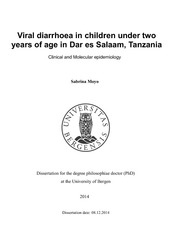| dc.contributor.author | Moyo, Sabrina John | en_US |
| dc.date.accessioned | 2015-02-24T14:15:20Z | |
| dc.date.available | 2015-02-24T14:15:20Z | |
| dc.date.issued | 2014-12-08 | eng |
| dc.identifier.isbn | 978-82-308-2763-5 | en_US |
| dc.identifier.uri | https://hdl.handle.net/1956/9428 | |
| dc.description.abstract | Introduction: Diarrhoeal disease is one of the leading causes of illness and death in children below five years, especially in developing countries. It is estimated to cause 0.7 million deaths among children younger than 5 years of age, most of which occur in children below two years age. Viruses such as rotavirus, norovirus and adenovirus are known to be major causes of infectious diarrhoea. Objectives: This study was done investigate the molecular epidemiology of rotavirus, norovirus and adenovirus and their association with demographic and clinical parameters including HIV and in children under two years of age in Dar es Salaam, Tanzania. Methods: This was a case control study conducted in Tanzania between August 2010 and July 2011. Cases were children admitted due to diarrhoea at three major hospitals of Dar es Salaam. Controls were children without history of diarrhoea for one month prior the study. These were either attending child health clinics for immunisation and growth monitoring or admitted due to diseases other than diarrhoea. Questionnaires were used to obtain demographic and clinical information. Stool specimens were collected from each study participant. We used ELISA methods for detection of rotavirus and adenovirus from stool specimens. Real time PCR was used for detection of norovirus. PCR followed by sequencing were used for typing all the three viruses. Results: Viruses were detected in nearly half (48.8%) of the cases and in 17.5% of the controls. Dual viral infection was found in 7.4% and 8.1% in cases and controls respectively. Among cases, rotavirus was the most common detected virus (32.5%) followed by norovirus (18.3%), and adenovirus (3.5%). In controls the prevalence of rotavirus, norovirus and adenovirus was 7.7%, 9.2% and 2.4% respectively. The peak prevalence of virus infection in cases was seen in the age group 7-12 months, 52.0%. Rotavirus G1P[8] predominated in cases and controls. Norovirus GII.4 predominated both in cases (87.9%) and controls (56.5%). Enteric adenoviruses contributed 50% in cases and 46% in controls. Rotavirus was more prevalent during cold than hot months during the study period. Rotavirus infection was significantly lower in HIV infected (15.4%) than HIV uninfected children (55.3%). There were no significant associations between HIV and either norovirus or adenovirus infection. There were no significant differences observed between viral infection and gender or parent level of education. Conclusion: Viruses contribute to a high burden of diarrhoea in hospitalised children of Dar es Salaam, Tanzania. We found a high frequency of asymptomatic carriage of diarrhoea-associated viruses in healthy children; these children may be a source of infection in the community. We observed a large genetic diversity of the three viruses investigated in this study. Pre-rotavirus vaccination data showed predominance of rotavirus genotype G1. Our study suggests that rotavirus may not be an opportunistic pathogen in children infected with HIV. | en_US |
| dc.language.iso | eng | eng |
| dc.publisher | The University of Bergen | eng |
| dc.relation.haspart | Paper I: Moyo SJ, Blomberg B, Hanevik K, Kommedal O, Vainio K, Maselle SY, Langeland N. Genetic diversity of circulating rotavirus strains in Tanzania prior to the introduction of vaccination. N. PLoS One. 2014; 20;9(5). The article is available at: <a href="http://hdl.handle.net/1956/8882" target="blank">http://hdl.handle.net/1956/8882</a> | en_US |
| dc.relation.haspart | Paper II: Moyo S, Hanevik K, Blomberg B, Kommedal O, Vainio K, Maselle S, Langeland N. Genetic diversity of norovirus in hospitalised diarrhoeic children and asymptomatic controls in Dar es Salaam, Tanzania. Infect Genet Evol. 2014; 26:340-7. The article not available in BORA due to publisher restrictions. The published version is available at: <a href="http://dx.doi.org/10.1016/j.meegid.2014.06.013" target="blank"> http://dx.doi.org/10.1016/j.meegid.2014.06.013</a> | en_US |
| dc.relation.haspart | Paper III: Moyo SJ, Kurt Hanevik, Bjørn Blomberg, Oyvind Kommedal, Svein Arne Nordbø, Samuel Maselle, Nina Langeland. Detection and molecular characterisation of human adenovirus in diarrhoeic children of Dar es Salaam, Tanzania; a case control study. Published as: Prevalence and molecular characterisation of human adenovirus in diarrhoeic children in Tanzania; a case control study. BMC Infect Dis. 2014; 14:666. The article is available at: <a href="http://hdl.handle.net/1956/10536" target="blank">http://hdl.handle.net/1956/10536</a> | en_US |
| dc.title | Viral diarrhoea in children under two years of age in Dar es Salaam, Tanzania. Clinical and molecular epidemiology | en_US |
| dc.type | Doctoral thesis | |
| dc.rights.holder | Copyright the author. All rights reserved | |
| dc.identifier.cristin | 1182564 | |
